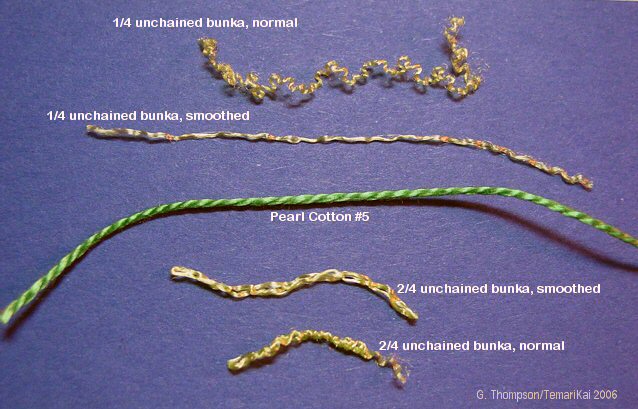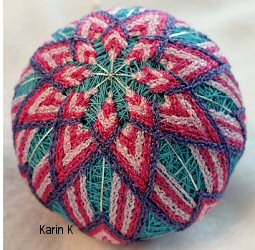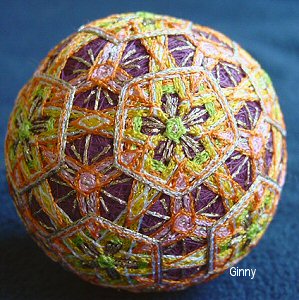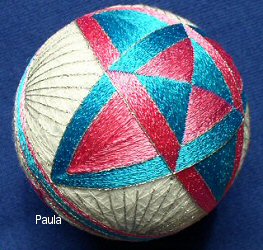Bunka Thread for Temari
Bunka (in Japanese this means "craft thread", and is pronounced "bun-ka") is a popular and traditional thread used to make Temari. Bunka embroidery is a traditional technique in Japan, done with a punch-needle and sometimes a brush (to create textures). It has been called "painting with thread" since tremendous shadings and textures can be achieved; there is an extensive color selection of bunka thread. Bunka thread found its way into temari applications long enough ago that bunka is a traditional fiber in Japan for for temari making, second only to silk. The original bunka was silk and it can still be obtained, but most modern bunka is rayon. The rayon version is much more affordable, and has a terrific sheen along with intense colors. There is a Western equivalent known as "chainette". Many are familiar with either one without knowing it; those slinky tassels (like on graduation mortarboards) and fringes on costumes are done with bunka.
Bunka is actually a tubular knitted chain, and most commonly comes in skeins but it can also come on larger spools or bobbins. Unless it is being used in tassels or the link it usually is "unchained" to a degree for embroidery use. The end is worked loose, and then gently pull - it unchains itself very much like when one had to open a bag of potatoes or onions that were in the heavy paper bags and "sewn" closed at the top (birdseed is probably more common in today's world). This is a diagram from vintage bunka that shows the process:

This diagram shows the chaining orientation at the far right, and how it "unchains". For most use the common stage is the "2/4" state - where there is still one chain step left intact. This is the most natural way that the cord unravels, as well. It gives a very nice gauge for stitching. If you do go down to the final 1/4 stage which is one thread with no chain it is finer - rather too fine for stitching for most people but, it does work well for marking division lines. It's easier once you start the "unchaining" to not cut the thread off past the unchained section. Leave a little bit of the unchained thread on the hank or bobbin, to continue pulling out when more is needed. This way the end doesn't have to be teased out again to restart the unchaining process. Unchained bunka is sometimes referred to as "Rydian", but this is not too common a term. When bunka is unchained, a much longer thread is obtained than the length removed from the skein, usually 3 to 4 times as much. Don't underestimate the cost effectiveness when purchasing bunka; it may seem pricey but a skein will go a much longer way than it looks. Unchained, bunka would be about in between pearl 8 and pearl 5 - thinner than the "traditional" Pearl 5 but, since it has been knitted up in that chain, it retains a unique appearance and texture after it is unraveled. It is a flat thread, however, not a cord like pearl cotton. It can be used alone (most commonly) or mixed with other fibers.
 This photo shows a comparison of Bunka in various stages of unchaining, set up against DMC Pearl Cotton #5. The "natural" degree of unchaining that usually occurs is the 2/4 (most desirable for stitching) - you really have to work to get a 3/4 or a 1/4, but it can be done, and you should be sure that you are consistently pulling a 2/4. A 1/4 is truly very fine - and a 3/4 actually looks a bit ungainly. You will see on the 2/4 example that has been smoothed with a damp cloth, that the appearance of the chain is still visible. When this works up on a temari it will be visible also and adds an added effect to the overall appearance. Notice the "curliness" of the normal or rough unchained 2/4. This may look a bit beastly to stitch with, but it truly is not. Use a bit of shorter working length than you might normally, and pull the thread through the mari a bit more slowly and carefully. It passes through the stitching surface smoothly. Changing the amount of tension while stitching will result in a unique texture to the completed design. Using very loose tension will retain even more "curliness" within the design and can look almost like the surface of a Turkish towel, or a boucle sweater. |
 "Rough" bunka - very loosely stitched |
 "Rough" bunka- normal tension |
 "Smooth" bunka - damped before stitching |
Intact bunka, unchained, serves wonderfully for tassels for the bottom/sides of temari. It is a very slinky cord, with a beautiful drape (remember those graduation tassels). While uncommon, there are instances when full bunka has been used as a stitching thread. It makes for a very dense, deeply textured temari. One note of caution - bunka seems to be rather prone to fading if left exposed to bright sun for longish periods.
This
is a TemariKai.com Printable Page; © 2014, all rights reserved.
Right click to print one copy for personal use.
Last updated 1/2014 © 1998 - 2014 TemariKai.com, G. Thompson/PuffinStuff, Inc.
